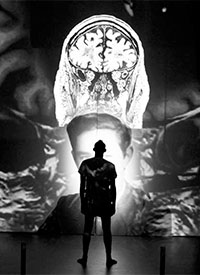 Photo: A.R. Sinclair Photography |
The Academy’s 1981st Stated Meeting on February 15, 2012, featured members of the Catalyst Collaborative@MIT performing a staged reading of Wesley Savick’s play Yesterday Happened: Remembering H.M. At the age of twenty-seven, H.M. (as he was known to the world) became frozen in time. After experimental brain surgery, he was unable to form new memories. His personal tragedy became neuroscience’s opportunity, contributing more to our understanding of the brain than had been learned in the previous one hundred years. The staged reading was followed by a panel discussion about memory and cognition. Four distinguished neuroscientists, including researchers who worked with H.M., explored the important contributions that this patient made to our understanding of memory, learning, and identity. An edited transcript of the discussion follows. (Image above: Barlow Adamson in Yesterday Happened: Remembering H.M., 2012, MRI scan of H.M. by André van der Kouwe.)
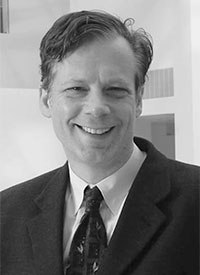
Robert Desimone
Robert Desimone is Director of the McGovern Institute for Brain Research and the Doris and Don Berkey Professor in the Department of Brain and Cognitive Sciences at the Massachusetts Institute of Technology. He was elected a Fellow of the American Academy in 2001.
Statistics suggest that half the people in this room will suffer from Alzheimer’s disease by age eighty-five. This extraordinary figure is sometimes dismissed by people outside the field because they believe it must be hype, but it actually is true. The best research shows a remarkable prevalence of Alzheimer’s disease. And although hardly a week goes by without some fantastic discovery about memory and Alzheimer’s disease being reported in the news (and we all are hoping for a cure very soon), I am 100 percent confident that every person in this room has spent some time seriously contemplating what the loss of their memory would be like. So it is with a combination of fascination and dread that we consider the case of H.M.
H.M. had his hippocampus removed by the neurosurgeon William Scoville, who believed that it would relieve H.M.’s otherwise incurable epilepsy. The surgery resulted in the complete loss of H.M.’s ability to form most types of memory, which therefore localized memory to the hippocampus, a structure roughly the size of your thumb. Why was this discovery so amazing? It was the early 1950s, and the idea that any functions were localized in the brain was not universally accepted until a few years before the case of H.M. Recall that in the early 1800s, phrenologists who made claims about localized functions in the brain were ridiculed by the scientific establishment. In 1906, Camillo Golgi and Ramón y Cajal shared a Nobel Prize for their work in neuroscience. In his acceptance speech, Golgi said that based on his observations of the brain, all brain cells were part of the same cytoplasm. Therefore, Golgi maintained, localization of function in the brain could not occur: each part was equal to any other part. Cajal proceeded to counter his co-winner, stating that based on his observations, the brain is composed of discrete elements, which have unique functions. Can you imagine this happening today with two Nobel Prize recipients reaching the opposite conclusion on the same question?
What occurred was a very sad personal tragedy for H.M., but it opened up the field of memory research. His memory impairments were initially reported by Brenda Milner, who is arguably the mother of modern neuropsychology. Just a short time later, she made another, perhaps equally amazing, discovery: that H.M. had not lost the ability to form all kinds of memories. She gave H.M. (who could not even remember meeting her the day before) a test in which he had to learn how to write by watching his hand in a mirror. It was a bit odd and required some practice, but with time, he learned to do the task. That observation initiated decades of work on trying to understand which forms of memory were dependent on the hippocampus, and which forms were dependent on other structures. Scoville had not just dissected out the function of memory from the other functions in the brain; his scalpel had in fact begun to dissect memory itself.
All our panelists worked personally with H.M., except for me. My work in memory is at the micro level and involves animals. My role in the case of H.M. is a sort of inherited involvement from my scientific mentor at the National Institutes of Health, Mort Mishkin, who performed a critical experiment in animals. Until that time, scientists trying to replicate H.M.’s amnesia in animal studies had failed to find any convincing evidence of the hippocampal damage causing the profound amnesia from which H.M. suffered. But Mishkin discovered that if he included a bit more of the temporal lobe, beyond the hippocampus itself, then the monkeys he used as subjects became similarly amnesic. This finding meant that humans, long thought to be unique in the way their memories were organized, shared many basic memory system properties with animals. That raised all kinds of questions about how the hippocampus interacts with other systems in the brain, and that debate has continued to this day.
Mishkin’s research also raised the question, what exactly was removed from H.M.’s brain? And that turns out to be another fascinating detective story. The chief detective in that story, Suzanne Corkin, will tell you a bit about the work involved in trying to figure out precisely what Scoville did. In fact, the surgical notes on the procedure are not quite accurate, and there have been a number of surprises in H.M.’s case throughout the years. I hope the members of our panel will also tell you a bit about their personal involvement with H.M. because I know that every one of them formed warm feelings for H.M. They felt a great deal of compassion for H.M. from working with him over the years. But the irony was that it was not reciprocated. He did not recognize them from day to day. It is interesting to imagine how you would form a relationship with someone who does not recognize you. Our panelists will tell you their accounts of this fascinating story.
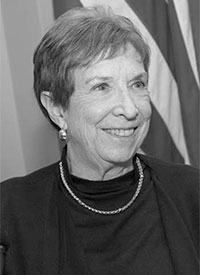
Suzanne Corkin
Suzanne Corkin is Professor of Behavioral Neuroscience in the Department of Brain and Cognitive Sciences at the Massachusetts Institute of Technology.
I will first show you an MRI scan of
Henry’s brain from 1992. Figure 1 is a horizontal
section, so imagine that the brain is
sliced from front to back. In this kind of imaging,
the bright white signal is cerebral
spinal fluid. It shows where fluid is present
and brain tissue is absent. In many cases, the
white patches indicate where brain areas
used to be. In sections A and B, you can see
in the back of Henry’s brain that his cerebellum
is badly atrophied. This loss is not an effect
of the operation; it is because he took
large doses of the anti-seizure medication
Dilantin for many years. But more important,
in sections C, D, E, and F, you can see
Henry’s lesion in both temporal lobes. The
damage extended 5.4 centimeters back from
the tip of the temporal lobe on the left side,
and 5.1 centimeters on the right side. Scoville
estimated that the extent of the lesion was
eight centimeters, so he greatly overestimated
how much tissue he took out. Only
with the advent of MRI have we been able to
obtain a more accurate idea of the true size
of the lesion.
Figure 1
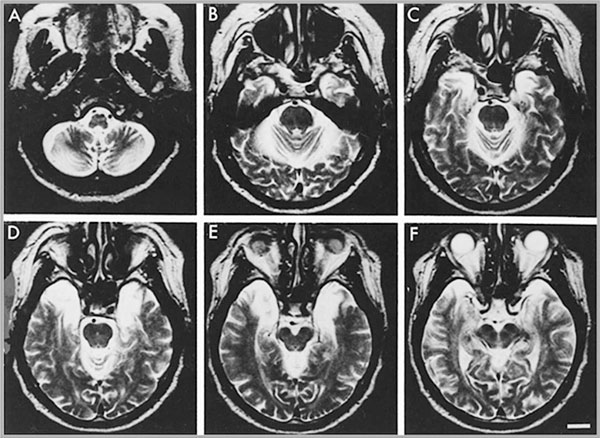
T-2 Weighted Axial Sections indicating the Extent of H.M.’s Anterior Temporal Lobe Resection Bilaterally. © Suzanne Corkin; used by permission of The Wylie Agency LLC.
The night Henry died, a hearse brought his body to the Martinos Center for Biomedical Imaging at the Massachusetts General Hospital, where we scanned him for nine hours in a 3 Tesla scanner. André van der Koewe put together a short movie of the images from one particular scan. These coronal images move from front to back as if you are looking at the front of Henry’s brain and progressing to the back. Starting in the front, the images show his eyes, nose, and frontal lobes. Next, the black areas reveal his enlarged ventricles and medial temporal lobe lesions, which are fluid-filled spaces in his brain. The images reveal that his corpus callosum is thin, and that, further back in the brain, the ventricles are still large. Finally, in the back, the images show the atrophied cerebellum.
In photographs of H.M.’s actual brain from right after the autopsy, in a ventral view, you can see the olfactory bulb on one side, both olfactory tracts, and the optic chiasm. In the back is his shriveled cerebellum, which would normally extend out farther on each side and also farther in back. The lesion begins just after the tip of the temporal lobe and progresses back. We think that the surgeon may have deliberately stopped just short of a blood vessel so that he did not cause more damage by cutting it. Similarly, on the left side, is the tip of the temporal lobe. The lesion extends back from here to another blood vessel. A close-up image of the left side of the front of the brain reveals the olfactory tract, the temporal lobe, and the lesion extending back from the temporal lobe and stopping; it is the same on the right side.
One question I am often asked is whether H.M. knew who I was. I worked with him from 1962 until he died in 2008. The answer is no, and yes. He didn’t really know who I was. He could pick my name out of a list of names beginning with C, but he didn’t know whether Corkin was a man or a woman, and he didn’t know what I did. But in recent decades, he always thought he knew me from high school. So when I asked him if we had ever met before, he would say, “Yes, in high school.” When I approached him in his room, or in the nursing home where he was living, he always thought that I was a friend.
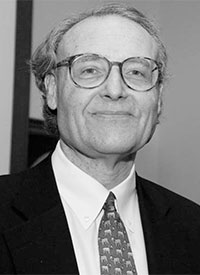
John D. E. Gabrieli
John D. E. Gabrieli is Director of the Athinoula A. Martinos Imaging Center at the McGovern Institute for Brain Research at the Massachusetts Institute of Technology and the Grover Hermann Professor in Health Sciences and Technology and Cognitive Neuroscience in the Department of Brain and Cognitive Sciences at MIT.
As a graduate student, I had the remarkable privilege of working with Suzanne Corkin and, for much of my Ph.D. thesis, with H.M. He was a wonderfully kind and cooperative participant, and he could not have been a better research collaborator. He did everything he could to help the scientists working with him learn as much as possible. The dramatic feature of H.M.’s condition, as Bob Desimone mentioned, was that the removal of a local section of tissue had resulted in a global amnesia; whether information was verbal or spatial, emotionally powerful or trivial, he remembered no events and very few facts from the day of the surgery to the day he died. There were some exceptions, but they were small compared to what is typical of a memory.
The primary lesson was that a local injury could have a global consequence for learning and memory. But the second lesson, which Bob also alluded to, was, in a way, the opposite: the short list of skills that H.M. could learn perfectly normally fueled another revolution. In modern understanding, the human brain is like a symphony orchestra of learning instruments. Between your ears are specialized circuits, all learning their own parts, typically collaborating, but operating to some degree as islands unto themselves. For an example, we can look to the studies of H.M. that Brenda Milner published in the early 1960s. In one test, H.M. had to trace a star that he viewed in a mirror. The outline of the star and his hand were blocked so that he could only view his hand moving in the mirror. Anyone asked to perform this task is slow at first. You make many mistakes as you overcome robot-like assumptions about how you move your hand and what it looks like when you move it. Like any other kind of skill, everyone gets faster and better with practice. Remarkably, after learning the skill, H.M. would come back the next day having retained it as well as anyone else – even though he had no idea that he had ever done it. This shows a fundamental distinction between, on the one hand, what is called declarative memory and, on the other, knowing a procedure without being aware of how you know it. It turns out that the basal ganglia, structures deep in our brains, support not only motor skills but also perceptual skills and cognitive skills. That finding provides an important insight into another separate, independent instrument of memory that allows us to be powerful skill learners.
The second class of learning, repetition priming, reminds me of an experiment that gave me the chance to work with H.M. Imagine that I ask you to name any weapons that come to mind. You might think of gun, knife, or maybe cannon. You probably would not list bazooka in your top three. Now imagine that before I ask the question, I give you a list of words to read, and on that list is the word bazooka. With H.M., I would wait a few moments, then ask him to tell me what the words on the list were. He would not remember them, or he would say, “What list?” Then I would say, “I’d like you to tell me the first three weapons you think of.” He would respond, “Gun, knife” – wait a moment – “bazooka.” And then he would add, “It’s funny, why did I think of ‘bazooka’?” His response was exciting because I knew that he had made an unconscious memory. He read the word bazooka, his brain changed, and when he had to produce the first couple of weapons he thought of spontaneously, one of them was primed to be bazooka.
A number of similar experiments have shown that individual words that are instantly forgotten leave another kind of memory trace in the brain that guides subsequent behavior. Psychologists have linked these findings to the experimental study of the human cognitive unconscious. When H.M. responded with the word bazooka, he did not know that he had seen the word, but when the moment came to behave and perform in the world, he was influenced by that recent experience as much as you and I would have been. Now, if you were the subject in that experiment, your response might be, “Do you want me to say ‘bazooka’? It was on the list I just read.” But if people in a psychoanalytic experiment are asked not to do that if they are asked simply to give the first one that comes to mind–they still come – up with bazooka. It happens just as often as it did with H.M. – not more, not less. It’s perfectly normal. In this way, he taught us that our brains are symphony orchestras of learning instruments.
We now know that the neocortex supports this kind of learning, and that within the neocortex are parts that support language and the representation of words and their meanings. We have learned from H.M., and from many researchers, that we have multiple memory systems between our ears, each specialized for learning different kinds of information. Remarkably, as much as they interact in everyday life for most of us – supporting each other, interacting with each other – they learn in isolation. They function like departments at a university or different sections of a bookstore, each with different kinds of knowledge and able to be independent. Without the examples that we discovered in H.M., as well as the large body of research that was inspired by those examples, we could have continued thinking that memory is a single entity. But this is not the case: memory is a fantastic diversity of different instruments geared to learn different kinds of things. These various instruments operate and send occasional messages to each other, but they lead independent lives in our brains.
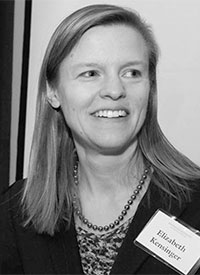
Elizabeth Kensinger
Elizabeth Kensinger is Associate Professor in the Department of Psychology and Director of the Cognitive and Affective Neuroscience Laboratory at Boston College.
Like John, I also was a graduate student with Suzanne Corkin and, in that context, had the opportunity to work with H.M. It is an honor to be here tonight to talk about both my personal experiences with him and what we learned scientifically. I will begin with an anecdote that highlights some of the preserved motor learning and implicit memory that John discussed, and that emphasizes the type of kindhearted person that Henry was. During my first year of graduate school, Henry was spending the night in one of the hospital areas at MIT. He often rode in a wheelchair for longer distances, and I needed to transport him through a series of indoor mazes to where we were doing the testing. Along this route were a number of places where, in order for the wheelchair to fit through the double door, I had to open not only the door on one side, but the door on the other side as well; and there was a complicated unlocking mechanism that went along with this task. Henry, who had been to MIT and traveled this path many times before, patiently waited as I opened the first door. As I struggled with the lock at the bottom of the second door, he reached down from his chair and effortlessly undid the lock. I don’t know if that showed some type of implicit learning, given that he had likely seen it done many times before. Or perhaps he just had far better engineering know-how than I did. Regardless, his gesture showed the spirit of generosity that was present in every interaction I had with him.
My primary research with Henry was looking for evidence of any new type of learning that was not of the implicit sort, to which he did not have conscious access. We were interested in whether he could consciously tell us about things that had happened after his operation in 1953. Many prior studies had suggested that he had not been able to acquire this kind of new information. A number of John’s studies showed that Henry was largely unable to learn new vocabulary words. If you gave him a word such as granola, for instance, he had no idea what it meant. But we decided to give him what seemed to be the easiest possible test, asking him for information about people who had become famous.
We absorb information about famous names all the time. Most of us do it effortlessly; we all probably know of Paris Hilton and Kim Kardashian, even though those names would not have registered with us a few years ago. What if we asked Henry about names of people who, prior to 1953, would not have been on his radar, but whom most of us came to know as household names after 1953? In a test I devised with Gail O’Kane, another graduate student with Suzanne Corkin, we first showed him two names, one of a famous individual and another that we had drawn at random from a Boston phone book. We asked him to select the name of the famous person. And as he started to choose these names, we were almost in disbelief. Not surprisingly, he did very well when presented with names of people that had been famous prior to 1953, choosing the correct name in the pair about 92 percent of the time. But even for the individuals who had become famous after 1953, he chose correctly 88 percent of the time. This performance was not only well above chance, but it was very close to his performance for the individuals that had been famous prior to his operation.
After he selected the name of the famous person, we would ask him to tell us why that person was famous. Often, he wouldn’t know, or he would be very wrong. One of his most amusing errors was telling us that Yoko Ono was an important man in Japan. Clearly, there were some names that elicited a sense of familiarity, but he did not have any other information to latch on to. However, for eleven of the forty or so people that he identified as famous, he was very good at providing information about why they were famous. For instance, he told us that JFK became president, that somebody shot him and he didn’t survive, and that he was Catholic. He said that Lee Harvey Oswald assassinated the president and that Mikhail Gorbachev was famous for making speeches and was the head of the Russian parliament. He wasn’t quite right about John Glenn, the first astronaut to orbit Earth; he said that Glenn was the first person to travel in space in a rocket, and that he went to the moon, landed, stayed there for a while, and returned safely. Considering that in 1953 space travel had not yet occurred, his answer was remarkable. He told us that Julie Andrews was famous for singing on Broadway, that Liza Minnelli was a movie star, an actress, and a dancer, too, and that Woody Allen was a comic in movie pictures.
So he did have an amazing ability to acquire and consciously generate new information. Certainly, he did not do so in the way that you and I effortlessly absorb new facts and new world knowledge into our repertoire. Nevertheless, it showed that even with the profound amnesia that made him unable to remember any single event after 1953, some kind of slow learning process allowed him to glean new knowledge.
Again, it was a remarkable privilege to work with him and to see what a generous person he was. The patience and the time that he gave allowed all of us, up until his last years, to continue to discover fascinating and novel aspects of how our human memories work.
Questions from the Audience
QuestionNow that you know about the local effects and the heterogeneous centers of knowledge acquisition, what would you say is the coordinator of this orchestra in the brain?
Suzanne Corkin
Many scientists have described a central executive in the brain’s prefrontal cortex. This area of the cortex carries out the highest, most complex cognitive functions. The current thinking is that this area helps you, first of all, to set goals. Second, it helps you lay out and think through all the steps that you need to take to achieve your goals, and then to perform them in the right order to reach the desired outcome. So, circuits in the prefrontal cortex coordinate the orchestra in the brain.
John Gabrieli
A leader in this field has said that the hippocampus, the structure that was removed from H.M.’s brain, performs the relational role of pulling together different bits of information across the brain – the constituents of the memory – that are not initially connected. In a sense, that’s the master orchestrator, though not necessarily the smartest orchestrator; knowledge may be in the cortex and elsewhere, but the hippocampus tells the brain that all these different things are the stuff of an event. The hippocampus forms the relationship that binds them together. Otherwise, they are isolated snowflakes, falling without leaving an imprint. In memory formation, without the hippocampus pulling everything together, we would be disparate and unconnected.
QuestionH.M.’s amygdala was also removed. Were his emotional responses tested?
Elizabeth Kensinger
When we tested Henry on labeling facial expressions, his performance was relatively normal. However, this ability is not unusual for patients with amygdala damage, who often rely on other types of knowledge to discern what, for instance, a caricature of a happy face looks like. In terms of the rigorous testing that we did, we did not see deficits in his ability to perceive whether someone was happy or sad.
Suzanne Corkin
One of the interesting questions about someone who is missing almost all of both amygdalae is whether he can experience a full range of emotions. Henry could do that. If he became frustrated, he could show anger, and when a psychiatrist who was interviewing him told him that his parents had died, he teared up appropriately. He had a great sense of humor. He made up jokes on the spot. One of his often-repeated lines was, “Knock on wood,” spoken while knocking on the side of his head. Many people have asked whether he was shocked to see an older man when he looked at himself in a mirror. He never was, and on one occasion said, “Well, I’m not a boy.”
Another interesting question is, was he afraid of anything? I have talked to his caregivers in the nursing home, and as far as I have been able to figure out, there was nothing he was afraid of.
QuestionCould H.M. walk or dress himself?
Suzanne Corkin
Following his operation, he could still do all the daily activities that we do. Henry could read, write, walk, talk, brush his teeth, shave, get dressed, and so on. Because of the Dilantin, he developed osteoporosis, suffered various fractures, and eventually began walking with a walker. He could still walk, but because of the cerebellar degeneration, he had a very broad-based gait. He walked slowly, with his feet apart for stability. But he walked until his legs could no longer support him.
QuestionI tell my students in introductory psychology that the case of H.M. shows that acquiring a new semantic memory requires intact hippocampi on both sides. How do you explain these quite surprising results?
Elizabeth Kensinger
The hippocampus is essential to learning new semantic knowledge in the way that most of us do: that is, after you hear a fact a few times, it becomes part of your knowledge repertoire. If we consider the famous people whom H.M. was able to generate information about, none of them became famous in 1980. We were testing him in 2002, and almost all eleven names he recalled were people who had been famous in 1960. It seems likely that most of these names were ones that he had been bombarded with over the years. Mikhail Gorbachev and John Glenn were not names that he heard once; those were names he likely heard at least hundreds of times. Even some of the actresses and movie stars whose names seem less familiar to us today could have been in films that were talked about in a number of personal genres. It suggests the existence of other mechanisms that we are largely unaware of because we do not rely on them very often; we do not need to focus on whether we acquire new semantic knowledge through thousands of exposures because we can learn it through a few exposures.
Suzanne Corkin
One of the giants in cognitive science, Endel Tulving, proposed that you can acquire new semantic knowledge without having an episodic memory or an intact hippocampus. He was right. Henry’s display of semantic learning was impressive given his profound amnesia, but it was very limited, and it was unlikely that the mechanisms he engaged for learning were identical to those used by the rest of us when we acquire semantic information spontaneously and prolifically.
QuestionMemory typically comprises acquisition and recall. Sometimes, there is information that you know you have, but you can’t retrieve it and have to learn it again. Could it be that the most impaired part of H.M.’s memory was not the storage or acquisition, but the recall?
Suzanne Corkin
When we tested H.M. on his semantic knowledge of events that happened before his operation, his capacity for retrieval was very good. We cannot attribute his memory deficits to a retrieval deficit because he could retrieve general knowledge about the world from before his operation. He could not retrieve knowledge about the world from after the operation because the information had never been consolidated and stored; when he tried to retrieve it, it wasn’t there.
Robert Desimone
Recall that the damage to H.M.’s brain extended beyond the hippocampus. In research that is now debated, Mort Mishkin and Faraneh Vargha-Khadem studied children who had suffered either prenatal anoxia or anoxia immediately after birth. They found that the damage seemed to be limited to the hippocampus. Those kids were able to learn many things normally: they went to school and learned to talk, but their recall was devastated. They could not recall a story that they had just heard. But they were able to learn many other kinds of information that did not require recall of a specific event.
QuestionMy question relates to the amygdala and fear. The amygdala is supposed to mediate recognition of the unfamiliar. When something was out of place, such as when a familiar landmark was not present, did H.M. show any sign of surprise?
John Gabrieli
H.M. was never surprised by devices that did not exist before 1953, such as digital clocks or the computers with which we tested him. He was not surprised by the moon landing and would not have been surprised by the possibility of people landing on Mars. Although as a time traveler he should have been in a state of constant amazement, as far as I knew, he was never surprised.
Suzanne Corkin
H.M. learned a great deal by mere exposure. He sort of knew what an astronaut was, and that they were weightless. He knew things you would never expect him to know.
© 2012 by Robert Desimone, Suzanne Corkin, John D. E. Gabrieli, and Elizabeth Kensinger, respectively
To view or listen to the presentations, visit https://www.amacad.org/content/events/events.aspx?d=482.